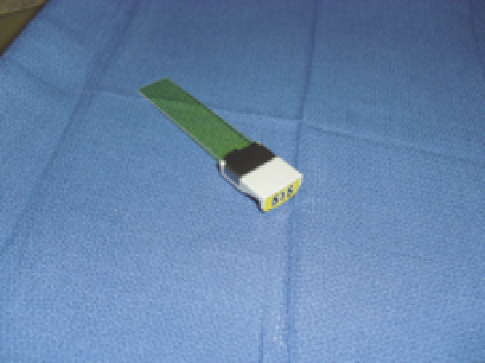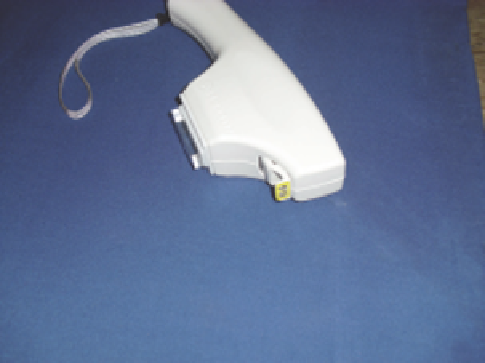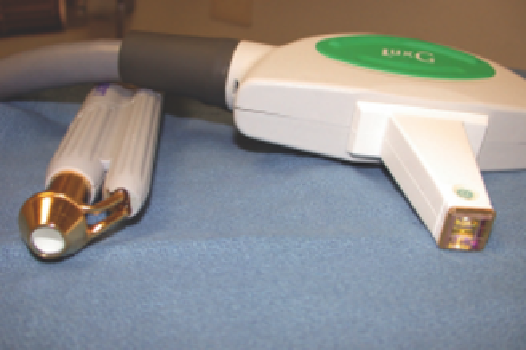Biomedical Engineering Reference
In-Depth Information
lesions. Both Iridex, Lutronic, ConBio, Cutera, and many others
manufacture 532 nm sources. The larger Iridex device (Gemini)
is an arc lamp drive device and the Cutera (Excel V) is driven by
a fl ash lamp. Both the Gemini and the Excel V create high pulse
energies over a range of pulse durations and spot sizes. The
Cutera device enjoys a higher peak power. Both are equipped
with sapphire contact cooling. Green light HgBO
2
absorption is
roughly 5× that of 595 nm and shows only about 10% more
melanin absorption. It follows that 532 nm enjoys a higher vas-
cular to melanin damage ratio than 595 nm. For smaller vessels,
user-selectable small spots (1-5 mm) can be applied. Larger
10-12 mm spots can be applied for larger areas (full faces and
chest, arms, and others). With a 10 mm spot size and 2 Hz rep
rate, coverage rates (cm
2
/sec) are similar to some IPLs (Fig. 2.7).
specifi c disorders. For most vascular applications, shorter
wavelength ranges are applied. There are two types of fi ltering:
absorption and interference. Most devices use the latter where
one slides a fi lter into the handpiece. The fi lters typically have
a value that designates the shortest wavelength that is allowed
through to the skin (Fig. 2.8). The cutoffs are not sharp. There
are over 30 IPL devices available in the USA alone, and world-
wide they account for a majority of vascular lesion treatments.
Critics decry the IPL as the poor man's vascular tool; however,
modern IPLs are sophisticated tools with tightly controlled
power supplies, integrated surface cooling, variable pulse
durations, and a variety of spot sizes. Some IPLs also allow for
double and triple pulsing with variable pulse durations and
pulse intervals to enhance effi cacy and decrease the risk of
nonspecifi c epidermal damage. Also, the multiple wavelength
output spectrum of an IPL allows for heating of both superfi -
cial and deeper vessels (Fig. 2.9). Furthermore, by pumping the
lamps less strongly, the spectra can be right shifted to favor
deeper larger vessel heating and greater epidermal sparing
(Fig. 2.10).
Intense Pulsed Light
IPLs are increasingly useful in vascular applications. Since their
development in 1992 and the US Food and Drug Administra-
tion clearance in 1995, refi nement in power supplies, cooling,
and fi ltering have increased their safety and effi cacy (12-14).
Modern IPLs rely on xenon fl ash lamps that, depending on
the way they are pumped, emit an unfi ltered spectrum. By
appropriate fi ltering, one can customize the spectrum for
Alexandrite Laser
The long pulsed alexandrite laser has emerged as a valuable tool
for vascular lesions. There is strong absorption for deoxy-HgB,
and overall blood absorption is 2× that of the 1064 nm Nd:YAG
laser. However, melanin absorption is also strong (about 3× that
of the 1064 nm Nd:YAG laser) so that the laser is best used in
lighter skin types and darker vessels. Darker-skinned patients
(up to type IV) can be treated but test sites are advisable as are
longer cooling times. Smaller darker red vessels can be treated
but higher fl uences might be required that risk not only epider-
mal damage but also bulk heating. We have studied the alexan-
drite laser for telangiectasia and found 6-8 mm spots the most
useful (15). Depending on the device, a range of pulse durations
can be used. Although 3 ms have been advocated in studies
of PWS, we have found that 20 and 40 ms clear telangiectasia
with a lower rate of purpura and epidermal damage. There are
a number of alexandrite lasers (Candela, Sciton, Cynosure
among them) with long pulsed capability. Cryogen spray, con-
tact cooling, and refrigerated air are integrated into these
devices, respectively.
Figure 2.7
Note 10 mm spot potassium titanyl phosphate tip (left) and 12
×
12 mm
intense pulsed light crystal (right).
(
A
)
(
B
)
Figure 2.8
(
A
) Slide in filter 515 nm cutoff and (
B
) accompanying intense pulsed light handpiece with 15 × 45 mm sapphire crystal tip.


















